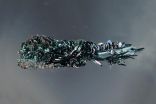"Caspase-1 acts as a lipid sensor in endothelial cells, which are abundant in the inner lumen of blood vessels," explained Xiao-Feng Yang, MD, PhD, FAHA, Professor of Pharmacology, Professor of Microbiology and Immunology in the Center for Metabolic Disease Research, Professor in the Cardiovascular Research Center and Professor in the Sol Sherry Thrombosis Research Center at TUSM, and senior investigator on the new study, which appears in print in the July 10 issue of the Journal of Biological Chemistry. "When lipids reach dangerously high levels in the circulation, the caspase-1-inflammasome complex initiates inflammation in the blood vessel," notes, Dr. Yang. "It turns out that caspase-1 signaling also inhibits endothelial cell growth, undermining the ability of the vasculature to recover from ischemic disease."
Ischemic diseases, which include heart attack, stroke, and peripheral artery disease, are a leading cause of illness and death in the United States. Ischemia starves tissues of blood and oxygen, resulting in severe damage to the blood vessels in affected tissues. Finding ways to therapeutically restore blood flow after ischemia without causing further tissue injury is a major goal in metabolic cardiovascular research.
Caspase-1 inhibition could prove to be hugely important in the treatment of ischemic disease. In their new report, Dr. Yang and colleagues show that the caspase-1 distress signals triggered by hyperlipidemia produce different effects in endothelial cells of differing size. In small endothelial cells, it triggers cell death, but in larger cells, it is involved in endothelial cell activation, in which the inner lining of the blood vessel undergoes a series of changes that ultimately contribute to the high lipid-induced inflammatory response.
"The growth status of endothelial cells is important to the inflammatory process," according to Dr. Yang. The major growth signaling pathway in endothelial cells is mediated by vascular endothelial growth factor receptor-2 (VEGFR-2), which also happens to be necessary for angiogenesis - the formation of new blood vessels.
In a series of experiments in human endothelial cells, Dr. Yang's team-- in collaboration with Hong Wang, MD, PhD, FAHA, EMBA, Associate Dean of Research, Director of the Center for Metabolic Disease Research, Professor of Pharmacology, Professor in the Cardiovascular Research Center and Professor in the Sol Sherry Thrombosis Research Center at TUSM, and Eric T. Choi, MD, Chief of Vascular and Endovascular Surgery at Temple University Hospital, and Associate Professor of Surgery at TUSM-- demonstrated that when caspase-1 was inhibited, VEGFR-2 activity was enhanced and the cells' angiogenic function restored. The cells successfully organized themselves into capillary-like structures in a tube-formation assay designed to measure angiogenic potential.
Similar effects on angiogenesis were seen in caspase-1-deficient mice with hyperlipidemia and hind-limb ischemia. Compared to hyperlipidemic mice with normal caspase-1 expression, mice lacking the sensor molecule had better blood flow and vessel growth in their ischemic limb.
"The findings describe the significance of the caspase-1 pathway to post-ischemia revascularization," Dr. Yang said. "From a therapeutic point of view, we want to try to trigger revascularization and make existing vessels recover as soon as possible. The novel caspase-1 signaling pathway could have therapeutic potential in this area."
Dr. Yang next intends to figure out how caspase-1 modulates the activities of endothelial cells and of bone marrow-derived stem cells, which function in vascular repair. In research published earlier in 2015, he and colleagues discovered that caspase-1 activation weakened the vascular repair activity of stem cells in hyperlipidemic mice. Those findings could have implications for stem cell-based therapies for ischemia.
INFORMATION:
Other researchers contributing to the new study include Jahaira Lopez-Pastrana, Lucas Ferrer, Ya-Feng Li, Xinyu Xiong, Hang Xi, Ramon Cueto, Jun Zhou Nelson, Xiaojin Sha, Xinyuan Li, and Ann L. Cannella at the Center for Metabolic Disease Research, the Cardiovascular Research Center and the Sol Sherry Thrombosis Research Center at TUSM; Xuebin Qin in the Department of Neuroscience at TUSM; and Princess I. Imoukhuede in the Department of Bioengineering at the University of Illinois-Urbana Champaign in Urbana, IL.
The research was funded by NIH grant HL094451.
About Temple Health
Temple University Health System (TUHS) is a $1.8 billion academic health system dedicated to providing access to quality patient care and supporting excellence in medical education and research. The Health System consists of Temple University Hospital (TUH), ranked among the "Best Hospitals" in the region by U.S. News & World Report; TUH-Episcopal Campus; TUH-Northeastern Campus; Fox Chase Cancer Center, an NCI-designated comprehensive cancer center; Jeanes Hospital, a community-based hospital offering medical, surgical and emergency services; Temple Transport Team, a ground and air-ambulance company; and Temple Physicians, Inc., a network of community-based specialty and primary-care physician practices. TUHS is affiliated with Temple University School of Medicine.
Temple University School of Medicine (TUSM), established in 1901, is one of the nation's leading medical schools. Each year, the School of Medicine educates approximately 840 medical students and 140 graduate students. Based on its level of funding from the National Institutes of Health, Temple University School of Medicine is the second-highest ranked medical school in Philadelphia and the third-highest in the Commonwealth of Pennsylvania. According to U.S. News & World Report, TUSM is among the top 10 most applied-to medical schools in the nation.
Temple Health refers to the health, education and research activities carried out by the affiliates of Temple University Health System (TUHS) and by Temple University School of Medicine. TUHS neither provides nor controls the provision of health care. All health care is provided by its member organizations or independent health care providers affiliated with TUHS member organizations. Each TUHS member organization is owned and operated pursuant to its governing documents.


